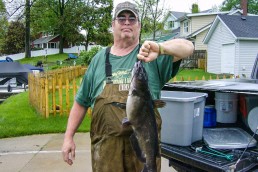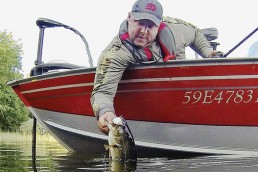Prepping for the Area’s Top Ten Catfishing Hot Spots
Soon we will be arriving at the peak time of the year for pursuing old Mr. Whiskers—that hard-fighting biting fish. So many great memories are made every year, waiting in anticipation under the glow of a lantern. And many cherished moments have been made as a youth on the banks of Cuyahoga River in Gorge Metro Park with friends while listening to an Indians game. I remember studying the tips of our heavy-action fiberglass rods in anticipation of possible channels and blues up to 40 pounds and the variety of nibbling bullheads. The process of trial and error kept us all on the positive side of the learning curve.
Assuming you are fishing an area inhabited by quality catfish, here is the gear I would recommend:
Start off with a fiberglass baitcasting (level wind) rod of at least medium-heavy strength. Fiberglass rods offer the flexibility to fling your baits long distances, while offering the strength to hoist large fish from considerable depths. Baitcasting gear offers superior drag systems and room for the high-capacity, braided or abrasion-resistant superline preferable for the sandpaper-like mouths of fish that spend the bulk of their time in and around river and lake bottoms filled with rocks, timber and other threats to monofilament.
I have little interest in catching bullheads, having decades ago surpassed my personal lifetime quota of the bothersome bait-stealers. With my concentration now on channel cats or blues, I’ve learned to have little use for worms of any kind or the variety of stink baits or cut baits still favored by those who subsequently spend an inordinate amount of their time dealing with bullheads of 1 or 2 pounds.
Switch to live minnows or shiners and you’ll find that bullheads won’t touch them, unless they’re dead. I like to employ a sliding sinker—of whatever weight is best for whatever condition I’m faced with—above a barrel swivel. The other end of the swivel will have a 2-foot monofilament leader tied on with the other end of that leader featuring a larger number 1 or 2 floating jig head. The color of the line or jig head is irrelevant, as all species of catfish are quite blind, relying exclusively on their sense of smell for efficient predation. The use of a floating jig allows the minnow or shiner to receive less resistance from the rig as the line pulls freely through the swivel, and the jig offers little weight to stress those expensive baitfish. I like to take my pocket or fillet knife and just slightly cut my baitfish just enough to enable scent disbursement.
When casting this rig, too many fishermen wind the offering up too snug before setting up their combo. This is where snags can come from. After casting, let the weight fall until line ceases playing out. Then slowly reel in until you encounter just minor resistance. This is the weight settling in.
Like most fish, the older a catfish becomes, the less palatable it is. The best “eating” cats are blues or channels of 2 to 4 pounds, and there are locations that have these.
Here are, by all accounts, are the area’s premier spots for catfishing:
LaDue Reservoir: Large, electric-only fishery on the Geauga-Portage County border with the premier catting nearer to the dam, closest to Route 422.
Lake Milton: Hubbard County entry is little renowned for its catfishing opportunities. It is underrated, and don’t overlook the river mouth at the south end.
Nimisila Reservoir: Disconnected member of the Portage Lakes Chain south of Akron, this surprisingly deep reservoir is home to a substantial army of shore fishing regulars. Many large channels are regularly hauled ashore.
West Branch Reservoir: A popular fishery just east of Ravenna is best known for its muskies, walleyes and crappies. Few tend to the considerable catfish population.
Portage Lakes: Most renowned as a bass fishing mecca, this series of bite-sized lakes offers steady and productive catting. East and Turkeyfoot are particular standouts.
Berlin Reservoir: A huge body of water just down from the West Branch always is a threat to produce some true heifers. The locals favor the old ramp and train trestle areas.
Lake Erie: You may not wish to handle them with anything short of nuclear pharmacy tongs, but there’s no denying the reliability of that nighttime breakwall bite.
Mogadore Reservoir: Once nationally famous as a panfish destination, this Portage County electric-only beauty is now regarded for its largemouth bass and catfish populations. Introduction of channel cats a decade or two ago has really taken off.
Ohio River: From Pittsburgh to Cincinnati, there are few reliable spots like this stretch for nailing a true catfish trophy. The area in Cumberland Pool out of East Liverpool is a personal favorite with good depths and an impressive population of a wide variety of catfish species.
Mosquito Reservoir: Atypical, shallow, eastern Ohio impoundment offers terrific catfishing off its renowned causeway breakwall. Big flatheads are a particular attraction here.
Jack Kiser is the host of TV’s “Buckeye Angler” and co-host of Fox Sports’ “Destination: Outdoors,” heard locally on WARF-1350 every Monday evening from 5-7 p.m. and Saturday morning from 6-8 a.m. You may reach him at the Facebook site for either program.
MWO
SHARE THIS POST
Did you enjoy this post?
You can be among the first to get the latest info on where to go, what to use and how to use it!
Jack Kiser
Jack Kiser is the host of “Buckeye Angler” and longtime Outdoors Columnist for the Kent/Ravenna Record-Courier and MidWest Outdoors and Ohio Valley Outdoors magazines. You may reach him at his Buckeye Angler Facebook site.



